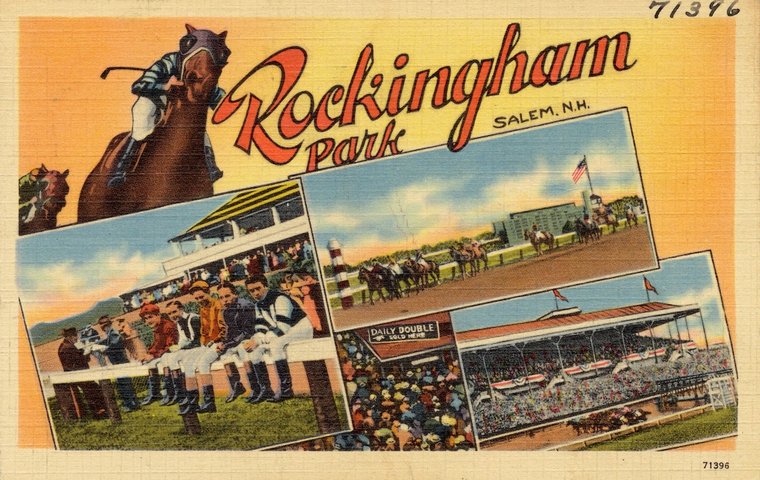
In the first of an unmissable new series, Rachel Pagones recalls the much missed New Hampshire venue that was not so much a racetrack as an institution – albeit one besmirched by the occasional murky episode
A partial list of items to be auctioned by James R. St. Jean, liquidators, during the weekend of September 24-25, 2016, included three Mack water trucks, two Ford ambulances, 45 poker tables, one Equicizer mechanical horse, a tow-behind horse ambulance, aging jockey silks, and 527 television sets.
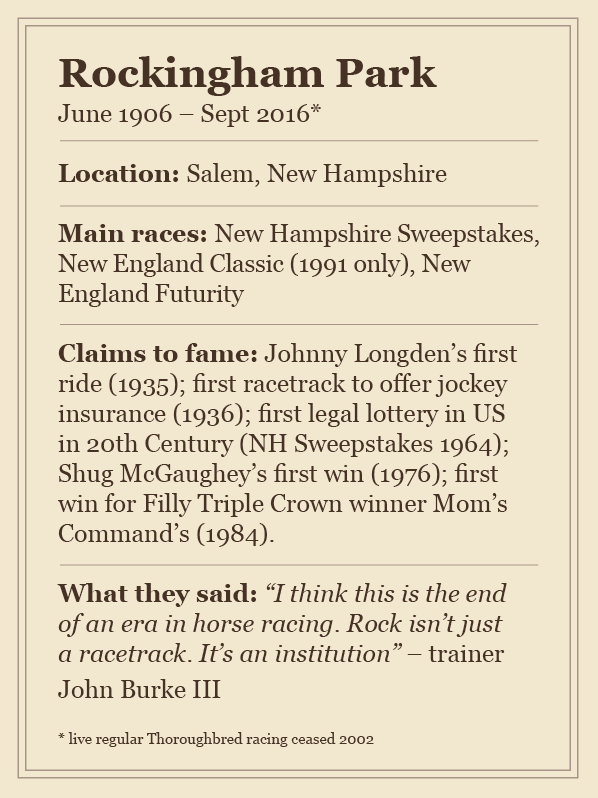 Left behind, at 79 Rockingham Park Boulevard in Salem, New Hampshire, were the bones of one Springsteel, a Thoroughbred racehorse who collapsed during a race at Rockingham Park in 1934 and whose memory was meant to live in perpetuity in the track’s infield.
Left behind, at 79 Rockingham Park Boulevard in Salem, New Hampshire, were the bones of one Springsteel, a Thoroughbred racehorse who collapsed during a race at Rockingham Park in 1934 and whose memory was meant to live in perpetuity in the track’s infield.
Sometime after the auction, Springsteel’s gravesite was ploughed under or built over. Posterity may or may not find the Tuscan Village, four million square feet of housing and consumer opportunities, lying over his remains. Who knows if any of its inhabitants is aware of the long-lost horse?
It is certain today, however, that there are many who can still picture the racing oval framed by pine trees and blue sky, and savour the odor of home-cooked food served on generous wooden tables in the track kitchen.
“Everybody loved Rockingham. Everybody looked forward to going up to Rockingham in the summer,” says Darrell Haire, who was a jockey at the New England track in the mid-1970s and has for 22 years been the Jockeys’ Guild western US region manager. “Especially after those cold winters at Narragansett or Lincoln Downs, or Suffolk Downs. The money was good, the people around the racetrack – it was really special.”
“It was really beautiful, green, paradise, and fun, and a good time,” says Debbie Ann Riemers-Downing, a jockey in the 1970s and 80s.
Jockey-turned-trainer Larry Handley, who spent time at ‘Rock’ in the 1960s, 70s and 80s, found an ageless charm. “You got that feeling like you were still racing back in the 50s when everything was grandiose,” he recalls.
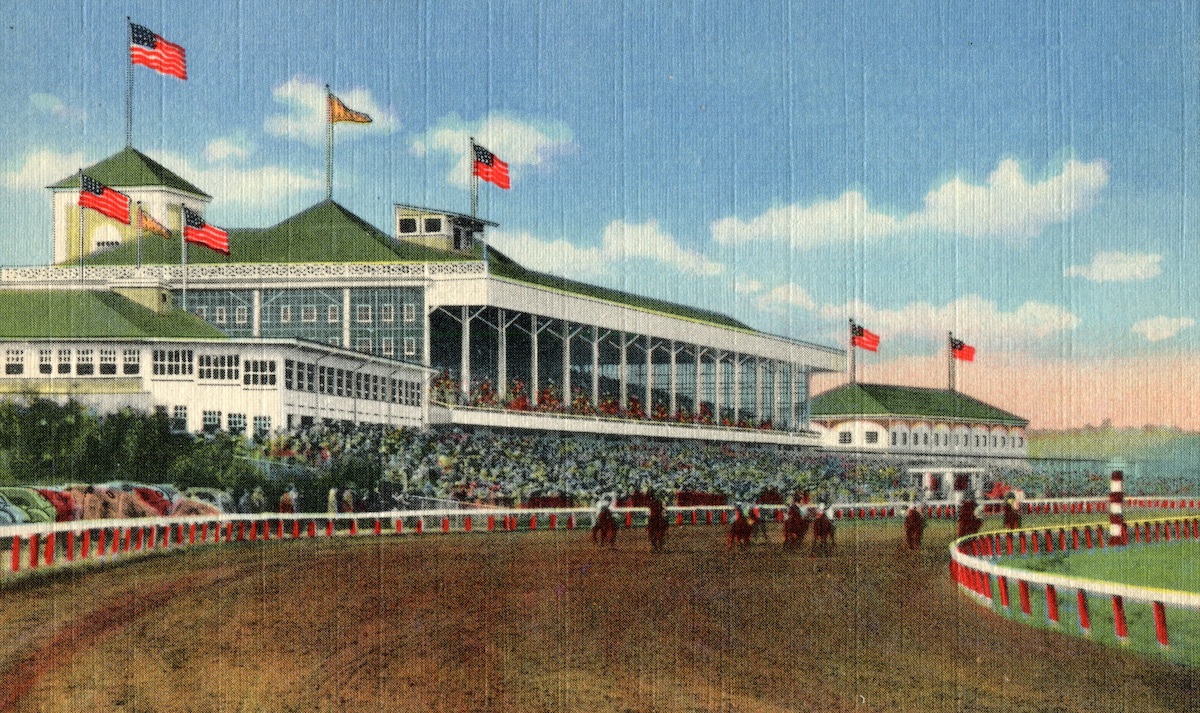
All racetracks are peopled by characters who drive a unique narrative, as much as great horses and great races do. At Rockingham that may have been true to an exceptional degree. “But all those folks were just a great big part of a huge hunk of glorious – well, some goodness, some badness,” says Riemers-Downing.
All of them are now closed
Rockingham Park was located in Salem, New Hampshire, about 30 miles north of Boston. Part of a necklace of racetracks unevenly draped around the states of New England – including Green Mountain Race Track in Vermont, Narragansett Park and Lincoln Downs in Rhode Island, Scarborough Downs in Maine, and Suffolk Downs in Boston – Rockingham was the prize jewel. All of them are now closed to live racing.
Rockingham Park began as a bold vision or a pipe dream, depending how you see it, in 1906. August Belmont II partnered with John ‘Bet-a-Million’ Gates, John A. Drake, and money from the Mellon, Vanderbilt and Whitney coffers to sink $1m into 437 acres and an idea that the citizens of New Hampshire would welcome gambling at a picturesque horse racing track.
Unfortunately, although at least 10,000 of them indicated they did by showing up on opening day, legislators did not. Gambling was quashed on day two, and although chaste horse racing continued for the meet’s scheduled 21 days, Belmont et al abandoned their big bet, along with a number of outstanding bills.
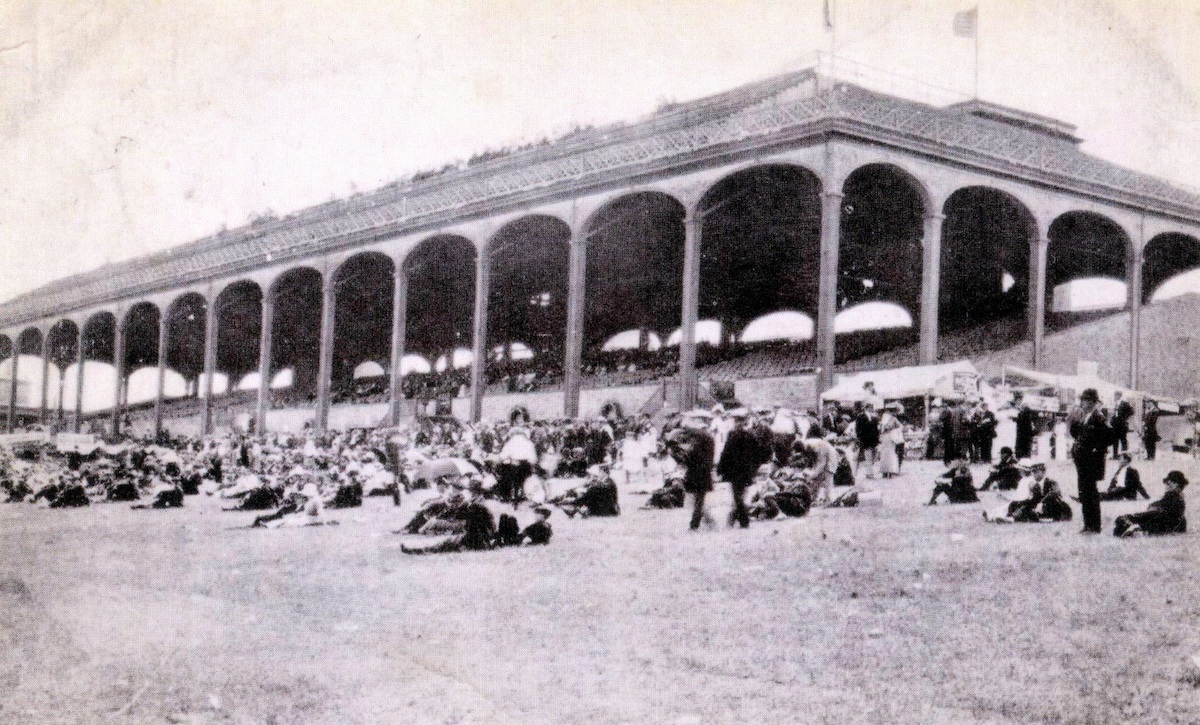 The site remained active, though. Other investors stepped in and Rockingham became variously an aviation park, an airmail launchpad, a fairgrounds, an army base, and an auto racing track.
The site remained active, though. Other investors stepped in and Rockingham became variously an aviation park, an airmail launchpad, a fairgrounds, an army base, and an auto racing track.
Everything changed, though, when in 1931 Lou Smith led a group of investors who purchased the track for $300,000. First, they paid off the debtors, setting a tone of cordiality and trust that would serve Smith well throughout his long tenure as dominant shareholder in the New Hampshire Jockey Club that would own and run the track.
However, their first meeting also fell afoul of anti-gambling laws and was shut down after a few days. Within a couple of years, though, Smith had worked his magic with the men in power. Legalized pari-mutuel gambling was in place when the races reopened on June 21, 1933.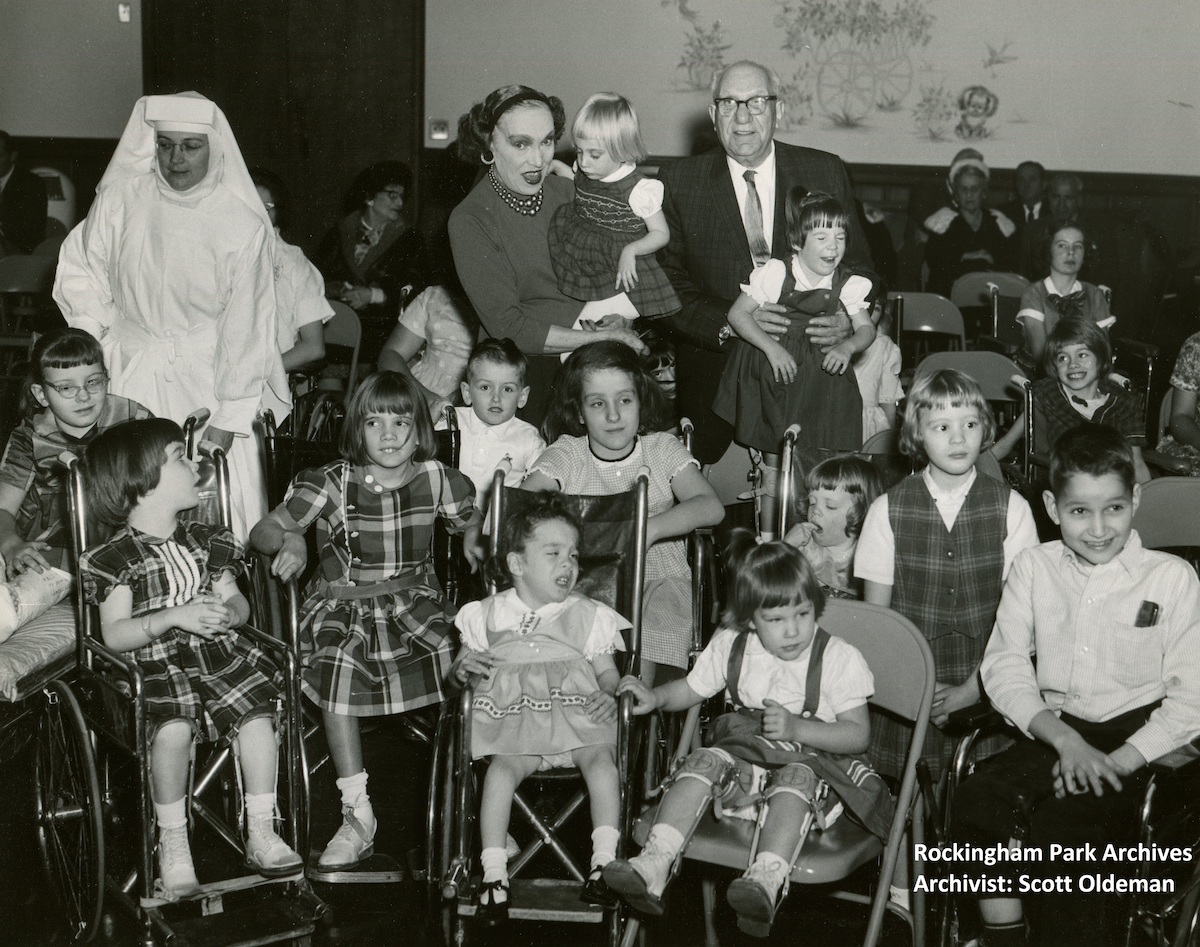
Lou Smith: an outsized presence
The most emblematic building at most racetracks is the grandstand; Rockingham’s iterations have all resonated within their particular era. The most iconic building in Rockingham’s history, though, was arguably the administration building, home to the apartments from which Lou Smith and his wife Lutza nurtured, observed, and presided over Rockingham Park for close to three decades.
Scott Oldeman grew up at the track, following his father, Ron, into work in the TV room and later in the racing office. Today his profession is engineering and product development, but he is also Rockingham’s dedicated archivist.
Visiting the administration building after the track’s closure was “like going on a trip down time, where it was kind of untouched,” says Oldeman. Despite his scientific training, he found it “spooky in a way … I felt almost like there was the presence of Lou Smith in the building.”
Certainly ‘Uncle Lou’ had an outsized presence in life. He mingled easily with the prominent and the powerful. The Smiths – who were Jewish – were close to Cardinal Cushing of the Boston Archdiocese, and the cardinal frequently celebrated Mass at the track when Lutza Smith held benefits for the Crippled Children’s Non-Sectarian Fund.
Smith had a bottomless trove of ideas for publicity and fund-raising. Locals were delighted, but visitors also came from further afield. Bing Crosby sent out his stellar Argentine import, Sabueso, to three victories in 1937. Alfred Vanderbilt’s Discovery was beaten at Rockingham, as was Seabiscuit in all five of his juvenile races in 1935, the same year that legendary jockey Johnny Longden rode in his first race – at Rock.
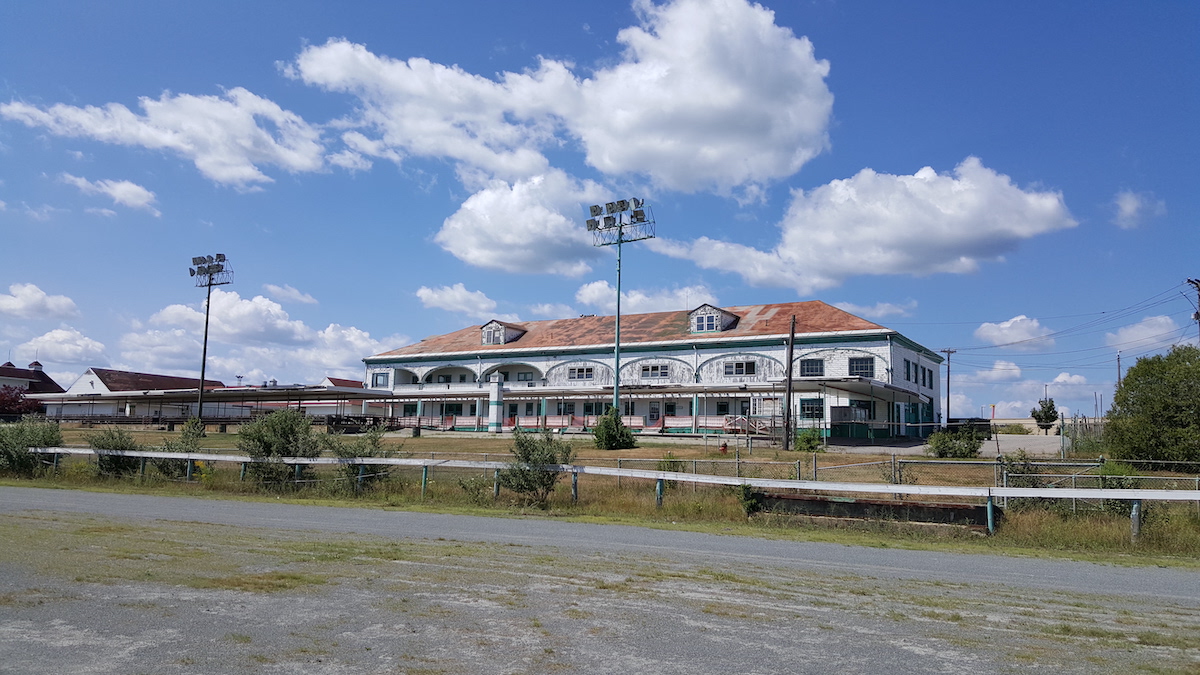 Balancing the spectacle side of Smith was his remarkable benevolence. Rockingham was the first US horse racing track to offer insurance for jockeys, in 1936, while in 1940 Smith spearheaded the creation of the Horse Retirement Fund to help rehome retired runners.
Balancing the spectacle side of Smith was his remarkable benevolence. Rockingham was the first US horse racing track to offer insurance for jockeys, in 1936, while in 1940 Smith spearheaded the creation of the Horse Retirement Fund to help rehome retired runners.
Sweepstakes state
By far the most influential spectacle launched by Smith was the New Hampshire Sweepstakes. Based on the Irish Hospitals’ Sweepstake, the race was a vehicle for the first legal lottery in the United States in the 20th century.
While it drew top contenders, the Sweepstakes lasted initially only four years. But the first event, in 1964, really was a scene, with $5.7m worth in tickets sold at $3 apiece. The winning horse would earn $94,133; the six top-winning ticket holders each banked $100,000. The race was won by the doughnut-eating, diminutive Roman Brother, the subsequent Horse of the Year. The great Dr. Fager took the prize-money in the 1967 final edition.
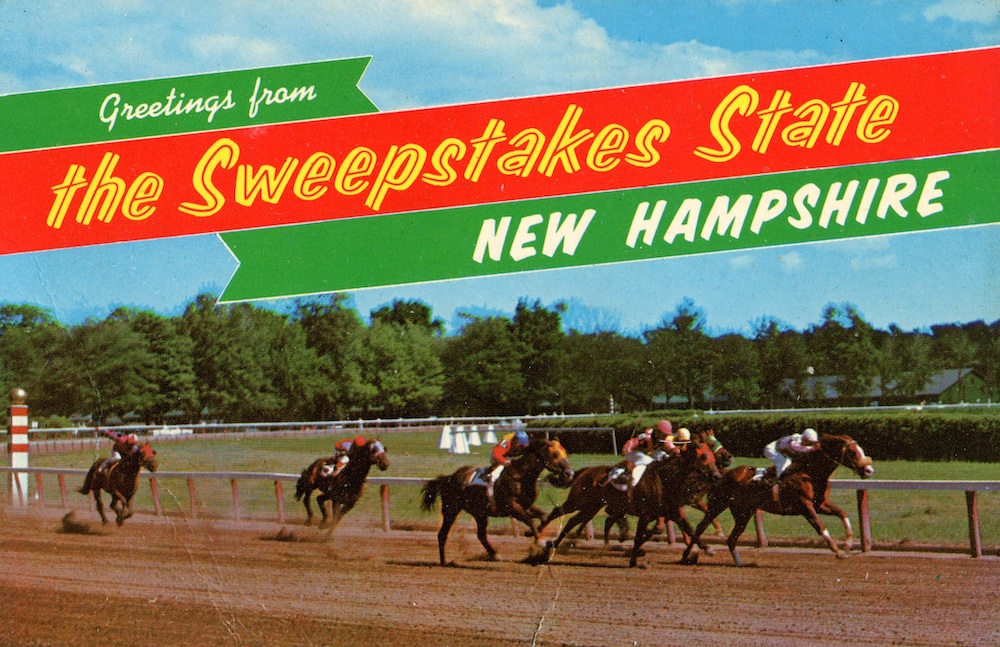
Two years after the Sweeps’ demise, Lou Smith died aged 81. It was the end of an unsurpassable era. The grandeur, the charity, and the squeaky-clean reputation required to fend off anti-gambling social conservatives could never again be matched.
Meanwhile, attorney Ken Graf, who had been Smith’s close counsel since 1933, took the helm. Under Graf, Rockingham continued to attract national talent. Apprentice jockey Greg McCarron and trainer Jack Van Berg tallied record wins in 1970; a few years later, Greg’s younger brother Chris made his mark on the way to lasting fame.
Then, on July 29, 1980, an early-morning fire raged out of control, destroying the grandstand. Many feared the track would be lost forever; as it was, the curtains went down on yet another period in Rockingham history. They would not rise again until 1984.
Rock as institution and family
Underlying all the changes was a constant thrum. This was life on the backstretch, as lived by trainers, jockeys, exercise riders, grooms, hotwalkers, and everyone else who kept the horses and the races ticking along. Even the four-year break was just a blip – everyone left, and then they returned, or others like them returned.
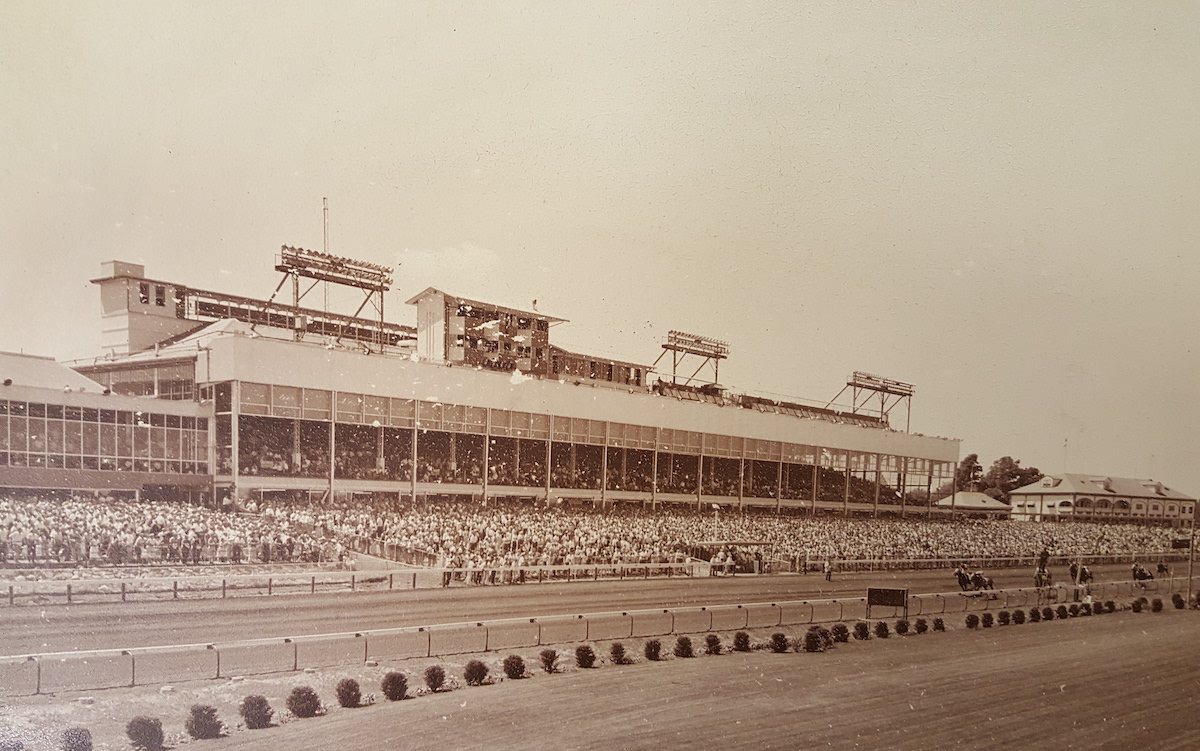 Often, there was a feeling of timelessness – particularly in summer, when lakes, beaches, and barbecues beckoned after racing and on dark days. “It was a really, really wonderful track,” says Darrell Haire of Rockingham circa 1975. “It was the little Saratoga of New England, with the lakes, and everybody had cookouts, and would go waterskiing … just big family up there.”
Often, there was a feeling of timelessness – particularly in summer, when lakes, beaches, and barbecues beckoned after racing and on dark days. “It was a really, really wonderful track,” says Darrell Haire of Rockingham circa 1975. “It was the little Saratoga of New England, with the lakes, and everybody had cookouts, and would go waterskiing … just big family up there.”
Larry Handley, who with his wife Debbie trained at Rock in the mid-1980s, recalls a tranquil area. “Salem was a charming little New England town, you could go down to the little mom-and-pop restaurants for lunch, and the feed company was still operating out of an old wooden building they had been operating since the 40s.”
The front side of the track played to the feeling, too, with its wood beams and hanging baskets and flowers everywhere. “It still had that feel,” says Handley, who also rode races at Rockingham in the 1960s and early 70s.
Many backstretch workers were raising their own families, creating a feeling of stability. Tack rooms became makeshift playrooms for young children, and older ones could walk over to the track kitchen with a couple of dollars to get breakfast or lunch.
Debbie Riemers-Downing and her husband were raising twin daughters. Despite the hazards of her job, she says: “My life was gentle. I was in that comfort zone of family, and 12 uncles, and the tack room, and all I had to do was to get my work done and go home.”
For those whose lives were harder, the track ministry, established in 1975, offered a hand. The ministry and local churches provided free suppers, drawing up to 100 people. There were Sunday dinners as well as numerous social programs. Chaplain Lee Alphen – a former harness horse trainer and driver – could often be heard relaying an uplifting message and prayer over the loudspeaker into the barn area.
Female ‘invasion’
But for all the comfort of continuity, throughout the 1970s and 80s social changes seeped in. The biggest, as far as racing was concerned, was the advent of female jockeys. Granted, Rockingham had long hosted races featuring female riders. The Lady Beautiful Purse for amateur women jockeys was part of a special card on Armistice Day in 1943, while the Gene Autry and Roy Rogers Cowgirl Races were a fixture each November during the 1940s and 50s.
These were exhibitions of exotica, though, on a par with plough-horse derbies and ostrich races (which also happened at Rockingham). Beginning in the late 1960s, women were licensed as jockeys, and New England quickly became a destination for young female as well as male riders looking to get mounts and hone their skills.
Indeed, Larry Handley met his wife, then Debbie MacFarlane, when she arrived at Green Mountain Park in 1969 as New England’s second licensed woman jockey. Handley was smitten, but also warned of an existential threat. He remembers being told of the female ‘invasion’ – “‘Do everything you can to keep them from getting a foothold.’ In other words, stop ‘em in any way you can.”
 Still, young female riders were drawn to Rockingham, among them Mary Amodie, Donna Barton (now Barton Brothers), Denise Boudrot, Tammi Campbell (now Piermarini), Dodie Duys, Abigail Fuller, Jill Jellison, Diane Nelson, and Therese Powers. There they found trainers willing to give them a chance, and a jockey colony that, if not entirely welcoming, was rich in life lessons.
Still, young female riders were drawn to Rockingham, among them Mary Amodie, Donna Barton (now Barton Brothers), Denise Boudrot, Tammi Campbell (now Piermarini), Dodie Duys, Abigail Fuller, Jill Jellison, Diane Nelson, and Therese Powers. There they found trainers willing to give them a chance, and a jockey colony that, if not entirely welcoming, was rich in life lessons.
A startling lesson
Donna Barton Brothers, winner of more than 1,100 races and daughter of pioneering jockey Patti Barton, was an apprentice at Rockingham in the late 1980s. While she soon moved on, she is grateful for the experience. “There were lots of things I loved about riding at Rockingham Park,” she says. “Namely, I got to have a lot of experience, I got to ride for a lot of different kinds of trainers and see different methods of training. I got to ride a lot of horses. And that’s the only way you’re going to learn.”
Some of the lessons were startling. She recalls a journeyman jockey who had helped her out once by creating an opening when her horse was trapped on another horse’s heels. In a race a couple of weeks later, she looked back to see the jockey in a tight spot himself and tried to reciprocate. He ignored her.Later, as Barton Brothers recounts: “He liked me, he had kind of taken me under his wing a little bit. And he said, ‘Hey kid, I appreciate you trying to help me but there’s one thing you need to know about me. Anytime I’m out there, I’m either pulling for a price or cashing a ticket.’”
The jockey was not alone. Barton Brothers remembers an incident in winter, when the track surface was frozen and the stewards appealed to the jockeys to hold one live race; rules would then allow the facilities to stay open for simulcasting the rest of the day. One of the jockeys asked if riders would be penalized for not pushing their horses, given the risky conditions. “No [penalty],” he was told.
Says Barton Brothers: “The girls ran one, two, three and the boys ran fourth, fifth, and sixth, and none of them persevered at all. All three of us did … and [we] were all the longshots in the race. And they all cashed tickets. I mean, it’s just the way it was.”
Being put on the lead was a common phenomenon for women jockeys. After Barton Brothers left Ro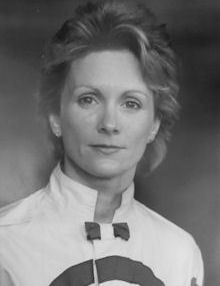 ckingham to finish her apprenticeship at Canterbury Downs in Minnesota, she says: “I thought honestly that I was a really, really good rider, because I won so many races at Rockingham Park. And then it took me probably about two weeks of riding at Canterbury to realize that I had been put on the lead more than I realized at Rockingham. It was that I probably just wasn’t as gifted as I thought I was.”
ckingham to finish her apprenticeship at Canterbury Downs in Minnesota, she says: “I thought honestly that I was a really, really good rider, because I won so many races at Rockingham Park. And then it took me probably about two weeks of riding at Canterbury to realize that I had been put on the lead more than I realized at Rockingham. It was that I probably just wasn’t as gifted as I thought I was.”
‘A lot of race-fixing’
Which is not to say holding horses was entirely the realm of male riders. “Yeah, I did a lot of race-fixing and I hate to tell you that,” says Debbie Riemers-Downing with a wry laugh. “But I think I’m the only one that will. It was just part of paying the bills.”
Having previously ridden – with notable success – in New England as Debbie Riemers, Riemers-Downing spent a time riding exclusively for her husband, leading trainer Michael Downing, at Rockingham. Later they divorced.
Michael Downing was indicted and pleaded guilty to felony charges in relation to manipulating odds in three races at Laurel Park in Maryland in 1991. Riemers-Downing was granted immunity for testifying against him. By this point, she wanted to set the record straight.
She looks back on it now as “a sad and kind of interesting time.Sometimes I would come back and the other jockeys would make fun of me. Because they knew what I was doing.”
Her take on that period at Rockingham today is to acknowledge that “race-fixing certainly existed there, corruption existed there. But it was paradise.”
And, she added: “Things did happen. But not to overshadow by all the goodness that also existed.”
Back on the national map
Rock’s second heyday, per Scott Oldeman, began in 1984 when the track reopened under the ownership of the Rockingham Venture Group. It was fronted by the brothers Joseph Carney and Dr. Thomas Carney and Edward Keelan, all of whom had greyhound interests, along with venture capitalist Max Hugel.
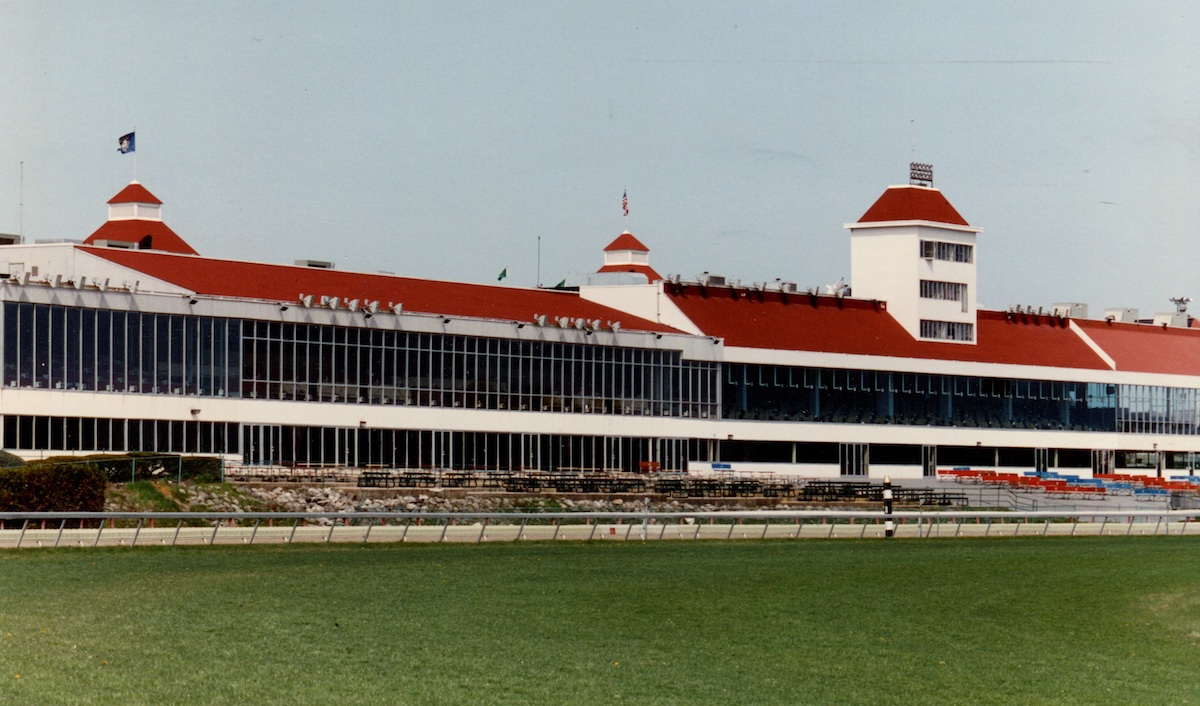 The old harness track was converted to a turf course, paving the way for the New Hampshire Sweepstakes’ metamorphosis into a mile-and-one-eighth grass contest. The race became a fixture for high-class shippers until 2002, with winners including the likes of Rainbows for Life, Fourstars Allstar, Kiris Clown and Hap. In the late 1980s, legendary jockeys Pat Day and Bill Shoemaker both made celebrated returns to the track.
The old harness track was converted to a turf course, paving the way for the New Hampshire Sweepstakes’ metamorphosis into a mile-and-one-eighth grass contest. The race became a fixture for high-class shippers until 2002, with winners including the likes of Rainbows for Life, Fourstars Allstar, Kiris Clown and Hap. In the late 1980s, legendary jockeys Pat Day and Bill Shoemaker both made celebrated returns to the track.
Having put itself again on the national map, Rockingham was rewarded when in 1991 the American Championship Racing series brought the New England Classic to Salem. The race’s half-million-dollar purse was the priciest ever awarded in New England, with the winner’s share going to multiple G1 winner Marquetry, brought from California by Bobby Frankel.
The year 1991 was a pivotal one in Rock’s fortunes. Attendance, says Scott Oldeman “started to go down as you had extreme competition from other areas, especially when casinos opened up in [neighboring] Connecticut. So 1991 was really kind of when Rockingham’s profit decreased by about 50 percent because of all that outside competition.”
Competition had been niggling at profits from the early 1970s, when Rockingham and Suffolk Downs first clashed over dates. The situation worsened after Rock’s reopening in 1984. State legislation added 50 more days to Suffolk’s racing calendar, creating a direct conflict during the cherished summer meeting. In the years to come, New Hampshire’s decision not to legalize slot machines helped seal the track’s fate.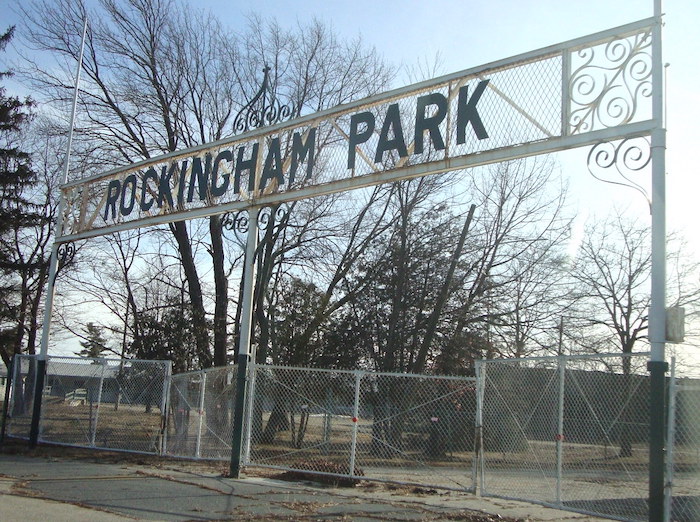
The last Thoroughbred race meet was held at Rockingham in the summer of 2002; the last Thoroughbred races took place on September 5, 2004, the grand finale of a special racecard. Harness racing ceased in 2009. And for the next seven years, people could go to Rockingham to gamble, but not on live racing (or slot machines).
Time enough, perhaps, for the demise to sink in, as weeds grew and facilities crumbled. Still, the final end, at midnight on August 31, 2016, was painful, and not only for racing fans. “To the people that grew up in Salem in the 60s and 70s, the racetrack was a big part of the community,” New Hampshire senate president Chuck Morse, whose mother had worked at Rockingham, told the Boston Globe.
It sounded like a refrain from 1980, when, after the grandstand fire, the Boston Globe’s racing correspondent Sam McCracken wrote: “Hardcore horsemen wept unabashedly… Because among the rubble lay nearly a lifetime of fond and happy memories.”
The memories, at least, remain.
Breeders' Cup update: latest plans from Europe and beyond – yes, no, maybe …
‘A lightning strike of a racehorse’ – Jay Hovdey on the tragically brilliant Lost In The Fog
Washington DC International: remembering the race that changed the world
Special feature: Where the turf meets the surf – but just what makes Del Mar so great?
View the latest TRC Global Rankings for horses / jockeys / trainers / sires


